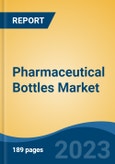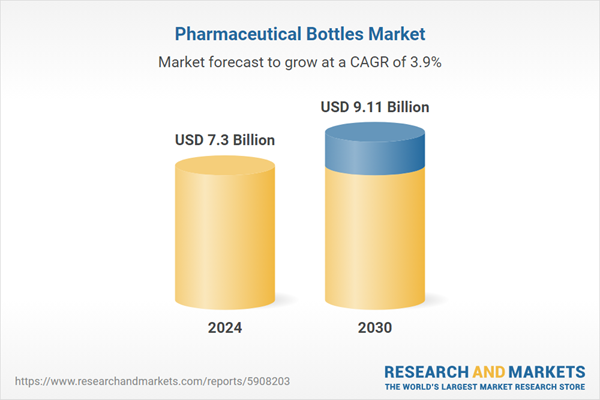Speak directly to the analyst to clarify any post sales queries you may have.
10% Free customizationThis report comes with 10% free customization, enabling you to add data that meets your specific business needs.
To prevent tampering and unauthorized access, pharmaceutical bottles often incorporate tamper-evident seals, bands, or shrink sleeves. These features indicate if the package has been opened or compromised. Pharmaceutical bottles are labeled with essential information, including the medication name, dosage instructions, expiration date, lot number, and manufacturer details. Branding and labeling are essential for product identification and regulatory compliance.
Key Market Drivers
Technological Advancements
Incorporating RFID (Radio-Frequency Identification) and NFC (Near Field Communication) technology into pharmaceutical bottle caps and labels allows for real-time tracking and monitoring of medication usage. This technology can provide dosage reminders, monitor temperature, and offer tamper-evident features. Advancements in child-resistant packaging technology have led to the development of sophisticated closures that are easy for adults to open but challenging for children. These closures often incorporate features like push-and-turn mechanisms or squeeze-and-turn caps.Tamper-evident seals and features, such as shrink bands and breakable caps, have become more advanced and reliable, ensuring the integrity of pharmaceutical products, and protecting against tampering. Serialization involves the unique identification of each pharmaceutical product and its packaging, typically using 2D barcodes or QR codes. This technology helps in tracking and tracing products throughout the supply chain, reducing the risk of counterfeiting and ensuring product authenticity. High-tech solutions like holograms, color-shifting inks, and specialty printing techniques have been employed to make pharmaceutical bottle labels and packaging resistant to counterfeiting.
Innovations in materials science have led to the development of sustainable packaging materials for pharmaceutical bottles. This includes bio-based plastics, recycled materials, and biodegradable options, reducing the environmental footprint of packaging. To protect the stability of pharmaceutical products, pharmaceutical bottles now come with advanced barrier properties. This helps to maintain the integrity of the contents by preventing moisture, oxygen, and UV light from affecting the medication.
Key Market Challenges
Counterfeiting and Product Tampering
Counterfeit pharmaceutical products can contain incorrect or substandard ingredients, posing serious health risks to patients. Tampered products may be contaminated or otherwise compromised, jeopardizing patient safety. Incidents of counterfeiting and tampering erode trust in pharmaceutical brands and the industry as a whole. Consumers may become wary of purchasing medications, leading to a decrease in patient adherence to prescribed treatments. Pharmaceutical companies are subject to strict regulatory requirements to ensure the safety and authenticity of their products. Failure to prevent counterfeiting and tampering can lead to regulatory non-compliance and legal consequences.The financial implications of counterfeiting and tampering are substantial. Pharmaceutical companies may incur costs related to product recalls, legal actions, and damage control. Additionally, they may experience revenue losses due to reduced sales and damaged brand equity. Incidents of counterfeiting and tampering can disrupt the pharmaceutical supply chain. This can lead to delays in delivering critical medications to patients and healthcare providers, potentially impacting public health during emergencies.
Key Market Trends
Sustainable Packaging
The use of eco-friendly materials for pharmaceutical bottles is on the rise. This includes the development and utilization of bio-based plastics, recycled plastics, and biodegradable materials. These materials reduce the environmental impact of packaging and promote circular economy principles. Sustainable packaging initiatives aim to reduce the use of single-use plastics and minimize plastic waste. Pharmaceutical companies are exploring ways to design bottles that use less plastic while maintaining product integrity and safety. Pharmaceutical bottle manufacturers are designing bottles that are easily recyclable. This encourages recycling efforts and reduces the environmental footprint of pharmaceutical packaging.Lightweight bottle designs are being adopted to reduce transportation costs and energy consumption during shipping. These designs maintain packaging integrity while using fewer resources. Some pharmaceutical companies are exploring reusable and refillable bottle systems, where patients can return empty bottles for refilling. This reduces the need for new packaging and minimizes waste. Sustainable sourcing of materials used in pharmaceutical bottles is a priority. This includes ensuring that raw materials are responsibly and ethically sourced. Sustainable packaging aims to reduce the carbon footprint associated with the production and transportation of pharmaceutical bottles.
This is achieved through energy-efficient manufacturing processes and optimizing supply chain logistics. Sustainable packaging must also comply with pharmaceutical regulatory standards to ensure product safety and patient well-being. Growing consumer awareness and demand for sustainable products are pushing pharmaceutical companies to adopt eco-friendly packaging solutions, including sustainable bottles. Many pharmaceutical companies have committed to corporate social responsibility (CSR) initiatives, which include sustainable packaging practices as part of their broader sustainability goals.
Key Market Players
- Berry Plastics Group Inc.
- Amcor Limited
- Gerresheimer AG
- Aptar Pharma
- Westrock Company
- Beckton and Dickinson Co.
- West Pharmaceuticals Services Inc.
- Schott AG
- Nipro Corporation
- O.Berk Company LLC
Report Scope:
In this report, the Global Pharmaceutical Bottles Market has been segmented into the following categories, in addition to the industry trends which have also been detailed below:Pharmaceutical Bottles Market, By Bottle:
- Dropper Bottles
- Liquid Bottles
- Packer Bottles
Pharmaceutical Bottles Market, By Application:
- Droppers
- E-Liquid
- Liquid
- Oral Care
Pharmaceutical Bottles Market, By End-User:
- Chemical
- Compounding Pharmacies
- Healthcare Centers
- Pharmaceutical
- Pharmaceutical Packaging
Pharmaceutical Bottles Market, By region:
- North America
- United States
- Canada
- Mexico
- Asia-Pacific
- China
- India
- South Korea
- Australia
- Japan
- Europe
- Germany
- France
- United Kingdom
- Spain
- Italy
- South America
- Brazil
- Argentina
- Colombia
- Middle East & Africa
- South Africa
- Saudi Arabia
- UAE
Competitive Landscape
Company Profiles: Detailed analysis of the major companies present in the Global Pharmaceutical Bottles Market.Available Customizations:
With the given market data, the publisher offers customizations according to a company's specific needs. The following customization options are available for the report.Company Information
- Detailed analysis and profiling of additional market players (up to five).
This product will be delivered within 1-3 business days.
Table of Contents
Companies Mentioned
- Berry Plastics Group Inc.
- Amcor Limited
- Gerresheimer AG
- Aptar Pharma
- Westrock Company
- Beckton and Dickinson Co.
- West Pharmaceuticals Services Inc.
- Schott AG
- Nipro Corporation
- O.Berk Company LLC
Table Information
| Report Attribute | Details |
|---|---|
| No. of Pages | 180 |
| Published | March 2025 |
| Forecast Period | 2024 - 2030 |
| Estimated Market Value ( USD | $ 7.3 Billion |
| Forecasted Market Value ( USD | $ 9.11 Billion |
| Compound Annual Growth Rate | 3.9% |
| Regions Covered | Global |
| No. of Companies Mentioned | 10 |









